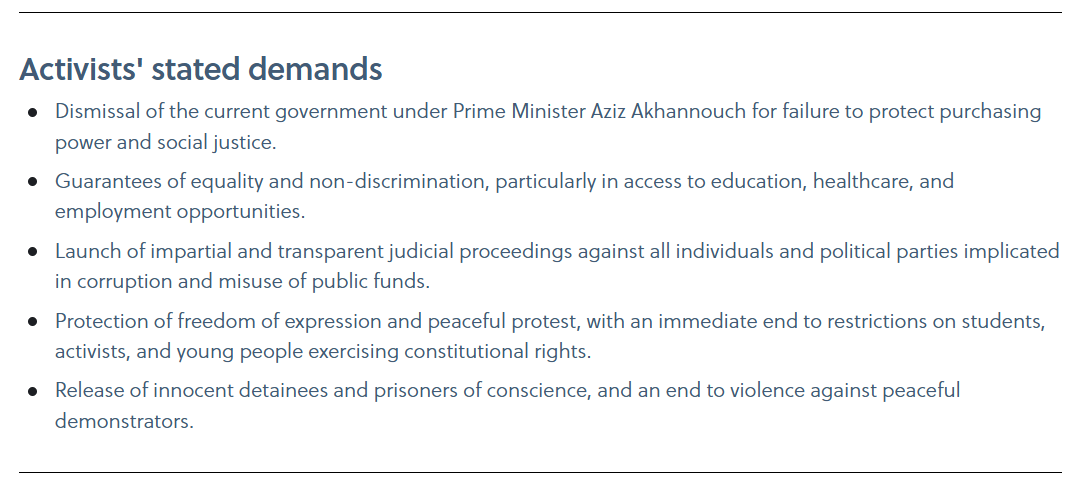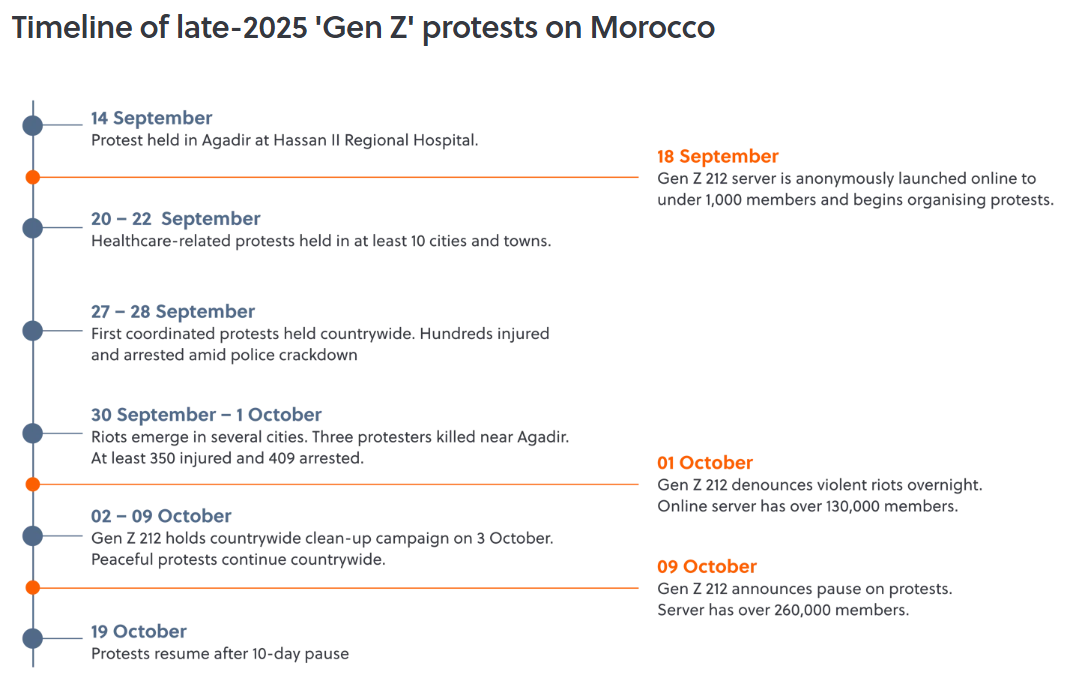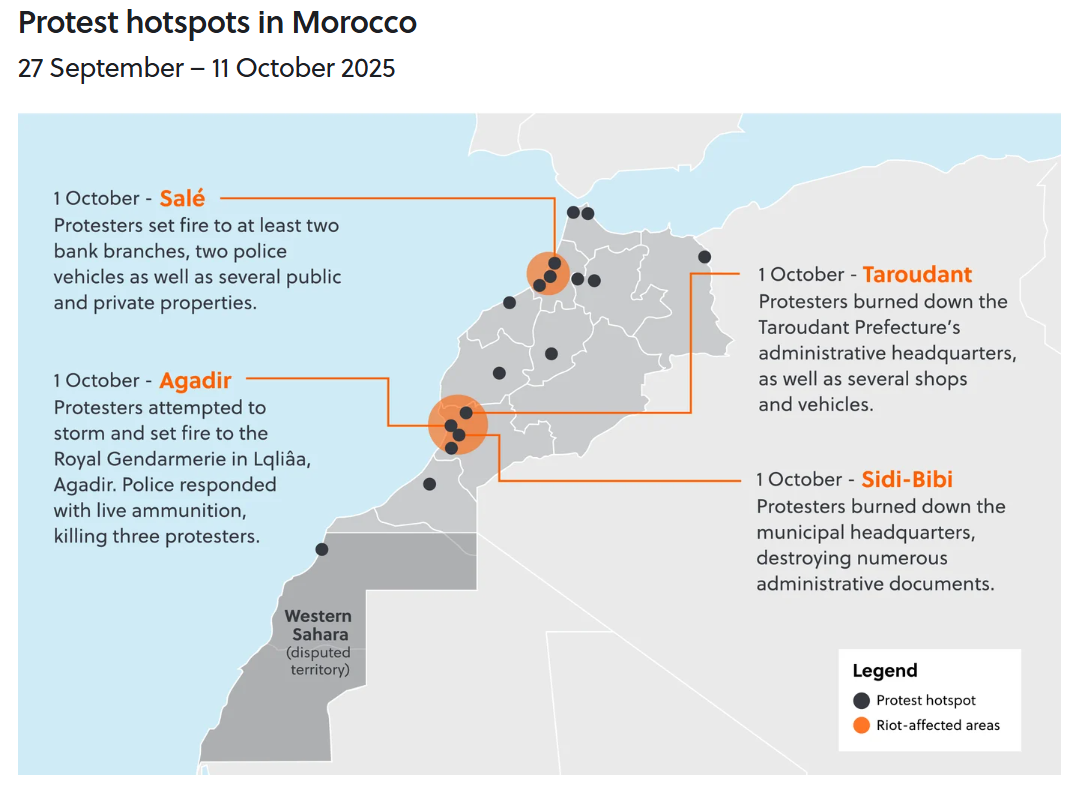Little fires everywhere: Morocco’s decentralised 'Gen Z' protests
On 14 September, hundreds of local activists protested outside the Hassan II Regional Hospital in Agadir to denounce the poor quality of healthcare at the facility, where eight women had died in the labour ward in the weeks prior. The rally was one of a multitude of protests in 2025 in which activists denounced deteriorating public infrastructure and demanded improved services. However, this protest set off a chain of events that culminated in the emergence of a large-scale protest movement by 27 September. As activists refined the focus of their critique on the government’s spending priorities and allegations of widespread corruption, protests continued to gain steam and, by the end of the month, erupted into widespread riots in which three people were killed.
Stadiums, but no schools
Though grievances surrounding Morocco’s public services are far from new, those tensions were amplified by the government’s successful bid to host the 2030 Fédération Internationale de Football Association (FIFA) World Cup. With Morocco also set to host the 2025 Africa Cup of Nations (AFCON) in December, the tourism-focussed capital expenditure required for the tournaments has become a key point of contention, with ordinary Moroccans perceiving the government’s willingness to host the events as prioritising them over domestic needs. Nearly 80 percent of Moroccans rely on public education and healthcare, underscoring the essential role government funding plays in ensuring consistent access for its citizens. This need has deepened in recent years as economic vulnerability and unemployment have intensified, with youth unemployment in particular nearing 40 percent in 2024. Inequality is also highly spatialised in Morocco, with the rural poor outnumbering their urban counterparts two-to-one while rural infrastructure lags far behind. However, public services have largely remained underfunded, suffering chronic shortages of both staff and equipment while associated infrastructure continues to deteriorate.

Forming online days after the 14 September protest, ‘Gen Z 212’ – the online community which serves as the movement’s strategic headquarters – proved instrumental in unifying the initial protests into a large-scale movement. The organisers, who remain anonymous, focussed on building grassroots support across political lines, and reducing the potential for divisions and internal discord. Moderators on Gen Z 212 avoided partisanship as well as questioning or critiquing the monarchy, the latter of which would have prompted a more severe crackdown in a country where the monarchy remains popular and largely insulated from criticism. Additionally, the community was anonymous and made decisions democratically, enabling supporters to both hide their identities and directly influence the movement. Meanwhile, thanks to the movement’s leaderless and decentralised nature, protesters on the ground were able to adapt day-to-day, tailoring their tactics to their surroundings and the police response to avoid being fully shut down. Sit-ins, rallies and marches were also coordinated to avoid violence and confrontations with police, maintaining popular support for the activists.

A turning of the tide
However, widespread violent unrest emerged following a 30 September incident in which a police vehicle swerved onto the pavement and gravely injured a protester in Oudja, Oriental Region. The incident signalled a turning point between police and protesters, with activists seeking out and directly attacking police. Riots emerged in cities including Salé, Casablanca, Sidi Bibi and Agadir, where protesters set fire to several government buildings and police stations. Protesters also engaged in violent clashes with police, with one incident in the Lqliâa suburb of Agadir involving 200 protesters attempting to invade and seize weapons from a gendarmerie, leading to police killing three. At least 350 people were injured countrywide, including 326 law enforcement officers, while 409 protesters were arrested, according to Morocco’s Interior Ministry. Additionally, at least 271 police vehicles, 175 private vehicles and 80 facilities were damaged, and early estimates indicate the cost of damages could range up to USD 21 million.

A fragile compromise
Despite the riots dissipating by 2 October, they marked a shift in authorities’ response to the movement from repression to a moderated acquiescence. The motive for this shift was clear: Morocco has a reputation at stake and the perceived repression of protesters could damage it. Police maintained their presence at protests but largely stopped dispersing demonstrators in the days after 1 October, a measure significantly aided by Gen Z 212’s quick issuance of a statement denouncing the riots. In a 10 September speech, King Mohammed VI urged parliamentarians to prioritise equitable development, oppose corruption and protect civic rights, effectively tabling Gen Z 212’s agenda without acknowledging the movement. Similarly, the government’s 2026 draft finance bill, released on 19 October, contains provisions to increase social spending on healthcare and education to nearly USD 15 billion – 10 percent of GDP – and create 27,000 new jobs, while not recognising activists’ demands for political resignations.
Looking ahead to the coming year, tensions will remain elevated as the government comes under scrutiny over fulfilling its stated commitments. Amid high public debt and annual budget shortfalls, the scale of the social spending allocation calls into question how the government will balance these domestic needs and its international ambitions. Missteps in managing this delicate situation may quickly trigger renewed demonstrations, especially as Gen Z 212 has indicated intent to protest until their demands are met and have demonstrated their ability to organise large-scale protests. Additionally, with Morocco set to host AFCON in December, there is strong potential for grievances with the 2030 World Cup to extend to the African competition, sustaining the threat of civil unrest in the coming months.
